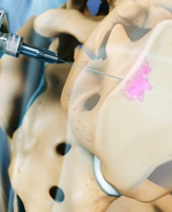Sacroiliac Joint Injections

A sacroiliac (SI) joint injection, also called a sacroiliac joint block, is primarily used either to diagnose or treat low back pain and/or sciatica symptoms associated with sacroiliac joint dysfunction.
The sacroiliac joints lie next to the spine and connect the sacrum with the hip on both sides. There are two sacroiliac joints, one on the right and one on the left. Joint inflammation and/or dysfunction in this area can cause pain. Read more about Sacroiliac Joint Dysfunction.
The purpose of a sacroiliac joint injection is two-fold: to diagnose the source of a patient’s pain, and to provide therapeutic pain relief. At times, these are separated and a patient will undergo a purely diagnostic or therapeutic injection, although often the two are combined into one injection.
The Sacroiliac Joint Injection Procedure
The Sacroiliac Joint injection procedure is usually performed in an operating room or a dedicated procedure room. The entire procedure usually takes only minutes, and the patient goes home the same day.
The following outlines the typical injection procedure:
- After informed consent has been obtained, the patient lies face down on his or her stomach on the radiography table. A pillow might be placed under the hips for patient comfort.
- The patient’s vitals (e.g. pulse rate and blood pressure) are monitored throughout the procedure.
- Depending on the physician and the patient’s preference, an intravenous line may be inserted to deliver medication to help the patient relax.
- To maintain sterility, the skin overlying the sacroiliac joint injection is cleansed using an iodine based solution (e.g. Povidine-Iodine) or an alcohol-based antiseptic (e.g. chlorhexidine 0.5% in 70% alcohol). Sterile gloves are used throughout the entire injection procedure.
- For the patient’s comfort, the needle insertion site is often numbed using local anesthetic. Once the needle enters the sacroiliac joint under fluoroscopy guidance, contrast – ‘dye’ that shows up under X-ray – is injected to verify needle placement within the sacroiliac joint and to verify spread of solution within the joint.
- Once the needle has been guided into the joint successfully, diagnostic and/or therapeutic medications are injected into the joint.
Two types of medications are typically injected:
- A local anesthetic (usually lidocaine or bupivacaine) is typically injected into the joint with the goal of determining immediate pain relief to confirm the sacroiliac joint as the source of the patient’s pain. This solution is used for a diagnostic sacroiliac joint injection.
- An anti-inflammatory medication (usually a corticosteroid) may help reduce inflammation within the joint, which in turn could help alleviate the pain over a longer period of time (typically for several months, up to a year).

